11 December, 2003
MacZ
This afternoon found us back up on Ray’s Gully again, this time carrying
up some of the other instrumentation that will be installed along with
the seismometer (see Ray’s Seismic Station). A quick pace
on the hike up the gully was required today as we were to meet the
helicopter from McMurdo at another station later in the afternoon. Once
we reached the top, we stored the equipment in the seismic box and then
laid out the cable for the antenna, burying it with rocks as we went.
The crater was cloudy today (Figure 1) so there was not much of a view
and, as it was getting windier, we didn’t mind heading back down to the
Skidoos immediately after the cable was installed (Figure 2).
MacZ is another seismic site located about 1,500 feet below the Ray’s
station. It is a beautiful overlook for Hut Point Peninsula and McMurdo
station. We had a clear view of the helicopter as it reached Castle
Rock, a large rocky outcrop between McMurdo and our location. From this
distance, the helo was barely visible as a dark speck contrasted by the
white snow. As it approached, we could make out its sling load – another
large wooden box filled with 70 pound batteries (Figure 3). The helo
circled, chose a drop zone, and deposited its load in a flurry of snow
kicked up by the propeller wash.
Our time at MacZ was brief today as all we had to do was move the
battery boxes into position next to the seismic station. Our job quickly
accomplished, we had some time to explore on the way home. We stopped at
several ice towers (Figure 4) to investigate possible ice caves.
Unfortunately, the first cave was too deep to explore without harnesses
and ropes, although it remains an intriguing possibility. The second
cave proved to be just one small room with a steep, snowy slope. Both
were worth the investigation as the wind had dropped and it proved to be
a beautiful day.
While we were exploring the caves, our helicopter had picked up Dr. Phil
Kyle and Dr. Clive Oppenheimer from Lower Erebus Hut. They were sampling
gasses directly from the plume today. This vantage point also provided
them with some great views of the crater. Flying toward the mountain
from the south provides a view of both Erebus and McMurdo station,
located at the tip of Hut Point Peninsula (Figure 5). The side crater,
Kurt Panter and Brian Winter’s field area (see 12/09/03 The Side
Crater), is visible on the southwest flank of Erebus (Figure 6).
Finally, a bird’s eye view of the whole crater briefly shows the lava
lake through the plume (Figure 7).
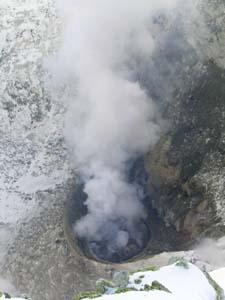
1. Figure 1 – The view of the crater from the rim above Ray’s Gully is not as clear today as it has been, but the lake is still visible. Looking carefully through the plume, you can still see the red lines that mark where convection cells are upwelling and breaking the hardened “skin” on the top of the lake.
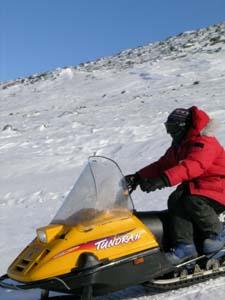
2. Figure 2 – Jackie skillfully navigates her Skidoo down Ray’s Gully. Notice that she is hanging her weight off one side of the Skidoo. This is to keep the snowmobile from rolling over when traversing a steep slope. Jackie’s had a roll here before, so she is careful to shift all of her weight now!

3. Figure 3 – After working up on the crater rim, we descended down the volcano to a seismic site called MacZ. This site overlooks Hut Point Peninsula, the Seasonal Ice Runway and Willie Field (the permanent ice runway). The helicopter (top left) in this photo is bringing a sling load of batteries and a large wooden box to the site. Behind the helo you can see Observation Hill (the large hill outside of McMurdo Station) to the left of center at the far end of the peninsula.

4. Figure 4 – After finishing our work for the day, we had some time to explore ice towers and potential caves on the way home. The cave in this photo proved to be too deep to enter without rappelling gear. The towers themselves though take on fascinating shapes. Hot, moist gasses venting from the ground around Erebus keep the caves warm, while the water vapor crystallizes to form the ice towers.
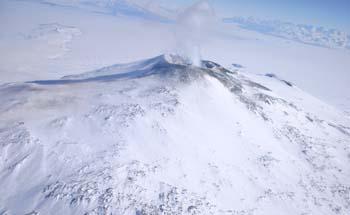
5. Figure 5 – After slinging gear to MacZ, the helicopter picked up Phil Kyle and Clive Oppenheimer to fly through the plume for gas measurements. The main crater is visible in this photo, while Hut Point Peninsula (where McMurdo Station is located) can be seen in the top left corner (Photo courtesy of Clive Oppenheimer).
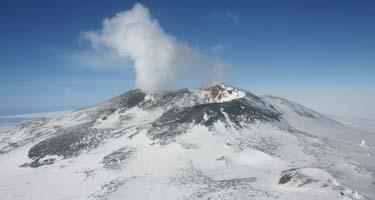
6. Figure 6 – This aerial view of Mt. Erebus clearly shows the smaller side crater in front of the main crater, which is steaming away in the background, providing a good plume for sampling (Photo courtesy of Clive Oppenheimer).
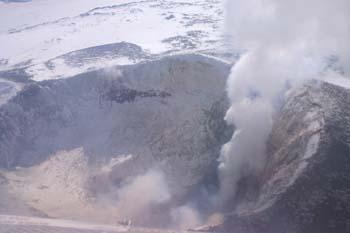
7. Figure 7 – One last view from the helicopter, looking directly into the main crater, shows the lava lake and Verner’s vent pumping out a good plume (Photo courtesy of Clive Oppenheimer).
Contact the TEA in the field at
.
If you cannot connect through your browser, copy the
TEA's e-mail address in the "To:" line of
your favorite e-mail package.
|
